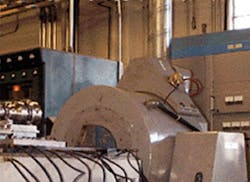Environmental testing simulates a wide range of physical phenomena. Temperature, vibration, and shock are among the most often specified parameters, but especially for military applications, salt spray, humidity, and altitude tests also may be required.
Courtesy of Equipment Reliability Institute
In the EE September/October 1970 issue, Thermotron advertised A.G.R.E.E. (MIL-STD-781) test chambers up to 6 ft x 6 ft x 4 ft with a -100°F to +350°F temperature range and room for a 48 in. x 66 in. vibration table. In the same issue, chambers from Standard Environmental Cabinet addressed MIL-STD-883 thermal shock requirements.
Wakefield Engineering offered a selection of burn-in equipment in the May/June 1972 EE. Also in that issue, Trio-Tech presented the Tracer-flo radiation-based hermetic leak tester, and Webber, Tenney Engineering, and Inreco provided environmental test chambers. Notably, Acton Environmental Testing advertised seismic testing with 24-in. displacement and 26,000 ft-lb capacity.
As described by Wayne Tustin, principal at Equipment Reliability Institute and a long-time EE contributor of vibration testing articles, the image accompanying this article shows a Ling water-cooled vacuum tetrode power amplifier to the left of the shaker. Ling used a 10,000-V power supply, and the tubes drove the shaker through a big step-down transformer. In the photograph, to the right of the MB Electronics (now MB Dynamics) shaker and the slip plate is an MB power amplifier, one of the first solid-state units. In the early 1960s, controllers were built into the power amplifiers.
In the July/August 1978 issue, Tustin’s article “Using Random Vibration in Electronics Evaluation” proposed pneumatic shakers for screening manufactured assemblies. For MIL/Aero qualification testing, the change from sine to random excitation took several years, but random vibration easily could be applied to find loose parts or bad connections without requiring accurate control and analysis.
Screening Systems advertised the Model QRS-100 tri-axial pneumatic-hammer-driven vibration system with temperature control in the May/June 1981 issue. As the 1980s progressed, the number of articles on burn-in testing increased.
In October 1983, EE ran a story about drop testing from Shure Brothers (now simply Shure and a major manufacturer of professional audio equipment). During a standardized drop test, it’s common to measure the forces exerted on a product within its protective packaging to establish how well the packaging did its job. Shure also did unpackaged drop tests to identify substandard batches of parts.
February 1985 saw publication of the GenRad article “A Method of Implementing MIL-STD-810D Random-on-Random Vibration Spectra.” Also in that issue, EJ Systems presented its computer-controlled burn-in technology. The “Burn-In Update” feature had become a monthly feature as had “EE Vibrations” contributed by Tustin.
Vibration testing continued to be covered during the remainder of the 1980s and throughout the 1990s, but environmental stress screening (ESS), highly accelerated life testing (HALT), and highly accelerated stress screening (HASS) were gaining popularity. Rather than test parameters sequentially, these techniques mixed stresses: vibration with high temperature and minimum supply voltage, for example. The object was to quickly determine the weak points in a design and fix them. This break/redesign cycle was repeated until the product reliably exceeded specifications.
EE attracted many well-known experts in the environmental test field. In addition to Tustin, founder of Tustin Institute of Technology, Sri Welaratna, Ph.D., from Data Physics and Gregg K. Hobbs, Ph.D., P.E., from Hobbs Engineering were among the authors writing for the magazine during this period.
As wireless communications gained more editorial coverage in the 2000s, the number of environmental test articles was reduced, but the quality remained. In 2002, George Henderson at GHI Systems wrote about shock testing, and Mike Albright, then at Roush Industries and today principal at Signal.X, discussed the application of Gabor joint time-frequency concepts for defining automotive noise.
Environmental testing extends to the network equipment-building system seismic testing that telephone companies perform to ensure that equipment racks will continue working through an earthquake. And, in 2009, Bloomy Controls described a centrifuge control system the company designed to assist in soil testing so the levees destroyed by Hurricane Katrina were stronger when replaced.
As we enter our next 50 years of service, test professionals can continue to look forward to a wide range of thought-provoking and current environmental test coverage.

